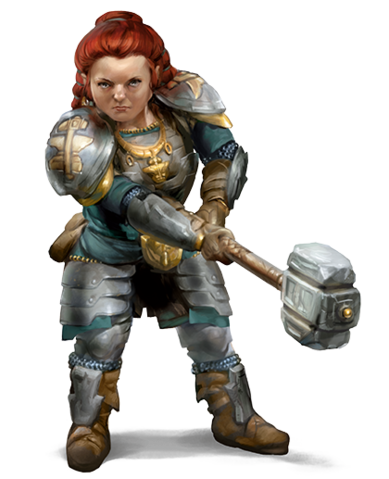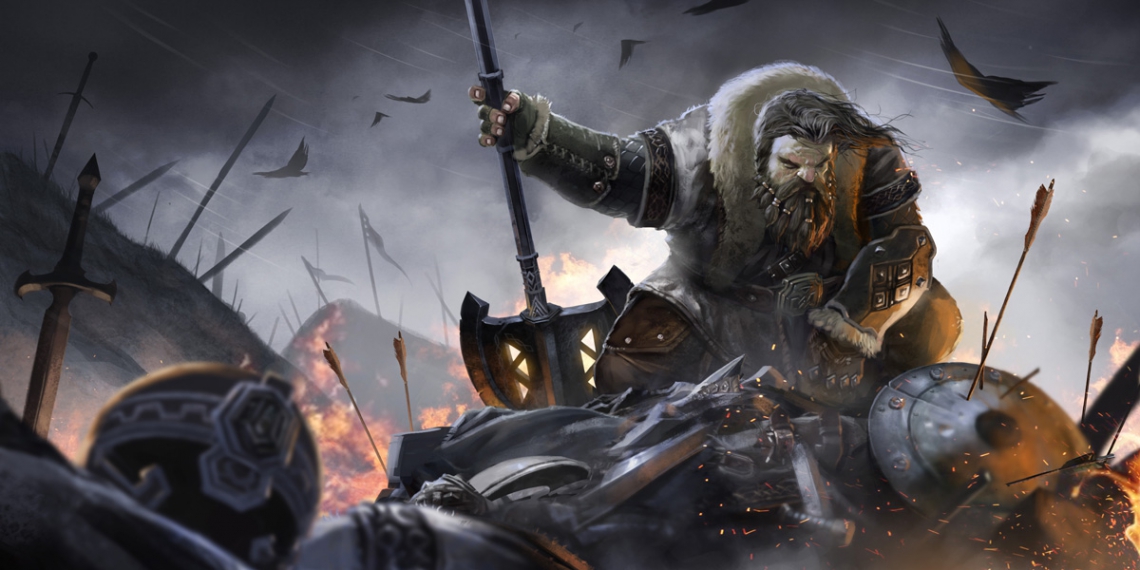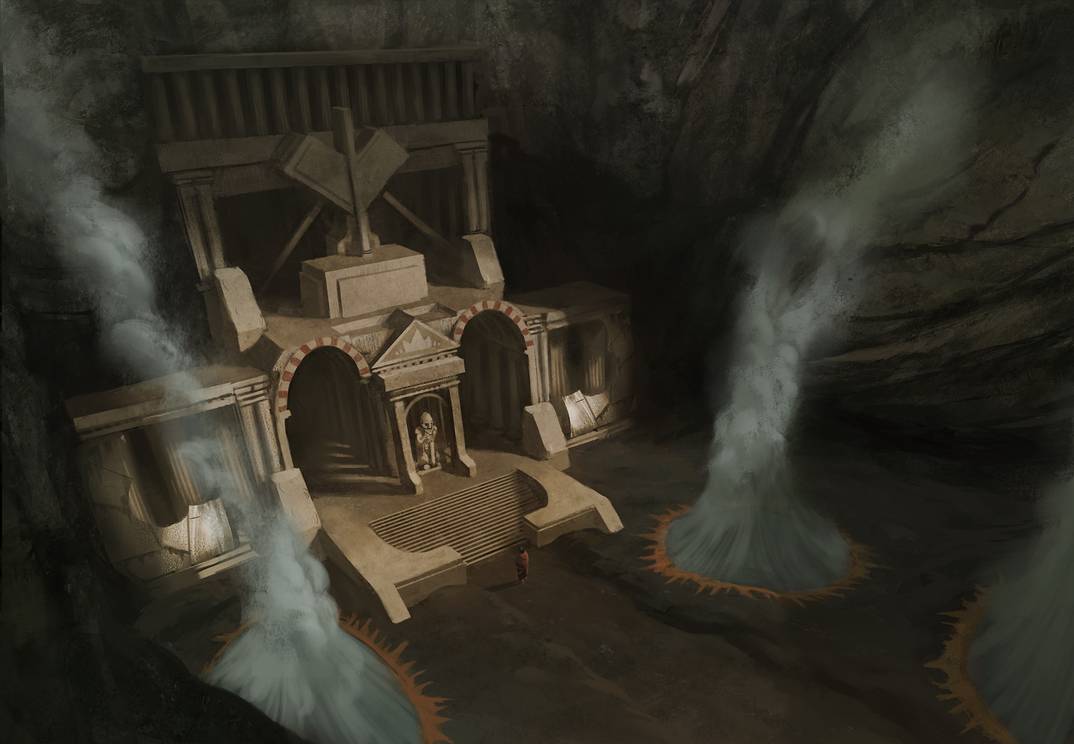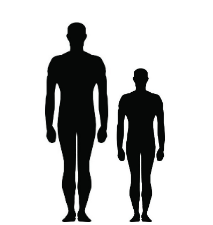Dwarf
"Look at their golden hills and silver mountains. Crafted high in honor to the lawful tenants of the Lawstone of Boldur. So inhospitable, and such a friend to the Dwarf!" -Jethro the ChroniclerThe Dwarves were the first humanoid species on the realm of Talamh. They are known for their skill in crafting, forging, and for their lawful society. They are primarily found on the continent of Eiren.
Basic Information
Anatomy
Like most humanoids, Dwarves are bipedal and have two arms. However, unlike most humanoids they are quite stout. Their skeletons are visually similar to humans, but the bones are smaller and wider. Their organ structure is also different than most humanoids, getting a much longer lower intestines which makes it so they can digest more food than most other species, albeit slower. Dwarves thus have slower metabolisms, which allows them to take on considerable bulk on their bodies. This also makes them store fat more easily across their body.
Biological Traits
When it comes to Dwarven sexes, they are like most humanoids but to extremes. Male Dwarves find themselves growing thicker and heavier facial hair and body hair while they are also more likely to go bald, and at much younger ages. Female Dwarves, meanwhile, are entirely incapable of growing facial or body hair but grow very thick and long hair on their heads, and are often more voluptuous in physical form.
Dwarves, due to their time of living in caves and still mining to this day, have an ability to see in the dark. Their hardy metabolisms also slow most poisons, allowing them to drink insane amounts of alcohol without getting drunk.
Hill Dwarves
Hill Dwarves mostly come from the desert region of Babash, thus nicknamed "Hill Dwarves" because of the sand dunes. Physically, they have tan or dark skin and dark, curly hair that descends from their heads and beards. They sweat much easier due to their thick skin. Their thick skin also makes them hardier for desert survival, with Hill Dwarves notably being able to live without food for, on rare occasions, up to 50 days. Their resilience of desert survival makes them better for meeting hard environments as well. Because of this, it isn't unusual to see Hill Dwarves being wiser than most others. As for height, they go from 4-4.5 feet.Mountain Dwarves
Mountain Dwarves usually come from the snowy environments of Gothai, more specifically Norden. Physically they are lighter skinned. Their hair can go from dark brown, brown, red, or blonde. Though their skin is like most humanoids, their muscles and stored body fat often exceed their Hill Dwarf cousins, allowing them to be physically stronger and more athletic. Mountain Dwarves are also taller than most other Dwarves, spanning from 4.5-5 feet.Duergar
The Duergar, known as the Grey Dwarves, hail from the deepest depths of Talamh due to being outcasts from the days when the Dwarves hid in caves. Their skin is a grey color normally, and their hair stays white throughout all ages. All male Duergar become bald when they hit adulthood. Female Duergar also grow no head hair along with facial hair, thus having a bald appearance. However, since they have lived in caves more than the other Dwarves, their dark vision is vastly superior. They also have a strange resilience to being charmed, and occasionally have the ability to increase their size and become invisible. Some speculate this is because they have an innate magical power within them.Genetics and Reproduction
Dwarves are pretty much identical to humans when it comes to reproducing. However, it is the gestation time for pregnancies that differs. Dwarven women carry their children for nearly an entire year (51 weeks) leading to larger infants being born. Like humans, dwarf women usually only have one child at a time, with twins occasionally happening.
Growth Rate & Stages
After being born, Dwarves actually mature at the same rate of humans, becoming fully grown by their late teens. However, they are still considered "young" until they reach the age of 50. At that age is when male Dwarves often have their facial hair fully thicken, and head hair for females fully thickens.
Ecology and Habitats
Dwarves, due to their slower metabolism, store much more fat across their bodies than most humanoid species, allowing them to survive in harsher environments. Hence why the two great Dwarven kingdoms, Babash and Norden, are in extreme environments of desert and tundra. Their strength and endurance also assist with this.
Dwarves also enjoy the harsher environments because they are more isolationist than most societies. In their early days they hid in caves, and they still enjoy mountainous regions because most do not traverse there. The harsh environments leave them to hording their own resources as well, like gold and iron.
Dietary Needs and Habits
Dwarves surprisingly do not need to eat a lot due to their slower metabolisms. However, because they have the capacity to eat a lot, they often overeat. Their ability to digest food slowly allows them to go without needing to eat meals for several hours longer than humans, letting them focus on work longer. The downside to this is that if a Dwarf is drunk, they remain drunk for much longer periods of time.
Dwarves usually tend to hunting or fishing in the harsh environments they live in, because farming proves to be disastrous. Eating animals or foraged vegetables or foods high in fat is their go-to answer for much-needed calories. If there is a lack of food, they sometimes resort to trading with humans or elves for breads and other high calorie foods for their mined resources.
Additional Information
Perception and Sensory Capabilities
Dwarves naturally are able to see in the dark due to their early history of living in caves. This "darkvision" is hindered by the lack of being able to see any colors, however, and only allows them to see 60 feet in front of themselves.
Civilization and Culture
Common Customs, Traditions and Rituals
Burials
Dwarves do not bury their dead like humans. Rather, they undergo the process of mummification in order to place their dead into tombs in the side of hills or mountains. These tombs are usually arranged for families to continually place their members and keep them together in the afterlife. Dwarves fear that not placing their ancestors in tombs will make their souls disturbed and wander the earth.History
The first two Dwarves, a male named Rishon and a female named Ishah, were created by Boldur after his hard work in crafting the universe. He commanded this couple to craft on the earth to their heart's content. Unfortunately, they ended up getting ingrained into Brigid's chaos and abandoned their commandment. Thus they were turned mortal for their rebellion against Boldur.
Pictured is a Dwarven Temple from Hollungrund, a sign of the Dwarven devotion to Boldur and the wisdom of Melekh-Navi.
The Dwarves, now mortal and fearing for their lives, resorted to hiding in caves for the first century. However, they would soon become braver and start facing the wilds with crafted weapons. They then got tools and started to build great kingdoms: Boldurun in the south of Eiren, and Norden in the north. Then, sometime in the 10th century, the great king Melehk-Navi gave the Dwarves the Lawstone and built a mighty temple to Boldur in the city of Babash. Melehk-Navi would pass away, but the Dwarves believed that he was an incarnation of Boldur and that another Melehk-Navi would come in the future.
The Dwarves would face challenge by Humans as they began to invade Eiren in the next 40 centuries. The Men of Lisanrik and Keller would form the Kingdom of Lysandus from Boldurun holdings (even stealing the Golden City and renaming it Ebenwald). The Men of Gothai would take Dwarven lands and turn it into Icen and Gotha. War would rage with the peoples for a long time.
Eventually, the Dwarves and Men would learn to co-exist on the continent with diplomacy. One example was Queen Dariah Halfdwarven, a half-dwarf who ruled Lysandus and had peace with Boldurun due to her parentage. The Confederation of Gothai brought human kingdoms together with the Nordens to bring a proper pact of strength as well.
Female Dwarf by Wizards of the Coast
A female Mountain Dwarf, endowed with plate mail and a hammer.
Scientific Name
Homo Sapiens Nanus
Lifespan
250 years
Average Height
4-5 Feet
Average Weight
150 lbs.
Related Organizations
Related Myths
Dwarven, (Lysandan) Common
Height comparison between the average Human and average Dwarf.
Remove these ads. Join the Worldbuilders Guild







Comments